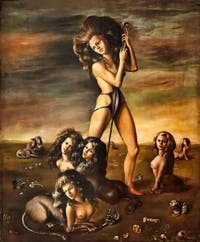Guggenheim Artists | Location | Opening Hours Tickets | Authorizations
Artists Picasso | Pollock | Braque | Calder | Chagall | Dalí | Ernst | Kandinsky | Léger | Magritte | Miró | Modigliani | Brancusi | Brauner | Campigli | Chirico | Delaunay | Delvaux | Duchamp | Fini | Hartung | Kooning | Laurens | Malevich | Man Ray | Masson | Marini | Mondrian | Pegeen | Pevsner | Picabia | Tanguy | Tapies | Twombly | Warhol
Leonor Fini “The Shepherdess of the Sphynx” at the Peggy Guggenheim Collection in Venice
Painting - Oil on Canvas (46.2 x 38.2 cm) 1941Leonor Fini was born in Buenos Aires in 1907. Her mother was Italian and her father Argentine.

Shepherdess of the Sphynx Arriving in Italy in Trieste, she was in contact with the intellectuals who frequented the family home, including James Joyce.
Without receiving any special artistic training, she learned part of her profession by working with Achille Funi in Milan.
In 1933, she went to Paris and met several members of the surrealist movement. Among them, Max Ernst, Salvador Dalí, Paul Eluard and Victor Brauner.
However, Leonor Fini never officially joined the surrealist movement. An informal membership that did not prevent her from being very close to it, especially at the symbols level.
She was significantly interested in the Sphinx, the mythological creature most admired by the majority of surrealists.
Peggy Guggenheim purchased this painting by Leonor Fini “The Shepherdess of the Sphynx” at Max Ernst's request, who had seen it in Fini's studio in Monte Carlo in 1941.
For Leonor Fini, the Egyptian Sphinx was a matriarchal and humanist figure.

Shepherdess of the Sphynx But the Sphinx has also long been associated with death and destruction before the transformation.
For Whitney Chadwick, this suggests that everyone have the power to form their own identity and reinvent themselves:
“By assuming the shape of the sphinx, Fini exercises all the lost female powers to return them to the contemporary woman.”
Whitney Chadwick
Fini's painting shows the shepherdess of the sphinxes in an apocalyptic, desert and arid landscape where the only signs of life are cut flowers scattered on the ground.
Broken bones, remnants of sphinx meals litter the ground of this dramatic landscape.
The shepherdess stands in the middle of her herd of eight half-female sphinxes, half lions. She has a lost look. She doesn't look at us or her sphinxes, she's somewhere else.

Shepherdess of the Sphynx Apart from her flesh-coloured socks and her breastplate, she is naked, bearing a kind of chastity belt that covers her belly like a shell.
Sensuality, eroticism, sexuality are the words that come to mind when looking at this shepherdess who holds her stick with both hands in a particularly ambiguous way.
The stick's symbol is prominent, but from there, all interpretations are possible, from the virgin who holds this stick that gives her sexual autonomy to the witch's broom, the surrealists are also keen on magic.
The lascivious pose of the sphinxes, the abundance of hair, the beauty of the bodies, the bodies of women and animals at once, symbols of desire, strength, protection, destruction: what are the roles and intentions of women here painted by Leonor Fini?
Artists Picasso | Pollock | Braque | Calder | Chagall | Dalí | Ernst | Kandinsky | Léger | Magritte | Miró | Modigliani | Brancusi | Brauner | Campigli | Chirico | Delaunay | Delvaux | Duchamp | Fini | Hartung | Kooning | Laurens | Malevich | Man Ray | Masson | Marini | Mondrian | Pegeen | Pevsner | Picabia | Tanguy | Tapies | Twombly | Warhol
Guggenheim Artists | Location | Opening Hours Tickets | Authorizations
Back to Top of Page

